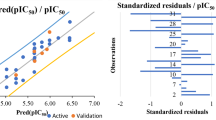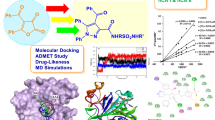Abstract
Pro-inflammatory activation of caspase-1 in the neurodegenerative pathway has been associated with age-dependent cognitive impairment and Alzheimer’s disease (AD) in humans. A recent report highlighted 2,4-diaminopyrimidine ring as an essential fragment in the inhibition of human caspase-1. However, the role of the ring and its enzyme inhibitory mechanism is not thoroughly investigated at the molecular level. The purpose of this study is therefore in twofold: (1) to understand the enzyme binding mechanism of the 2,4-diaminopyrimidine ring and (2) to search for more potent caspase-1 inhibitors that contain the ring, using integrative per-residue energy decomposition (PRED) pharmacophore modeling. Ligand interaction profile of a reference compound revealed a peculiar hydrogen formation of the amino group of 2,4-diaminopyrimidine with active site residue Arg341, possibly forming the bases for its inhibitory prowess against caspase-1. A generated pharmacophore model for structure-based virtual screening identified compounds, ZINC724667, ZINC09908119, and ZINC09933770, as potential caspase-1 inhibitors that possessed desirable pharmacokinetic and physiochemical properties. Further analyses revealed active site residues, Arg179, Ser236, Cys285, Gln283, Ser339, and Arg341, as crucial to inhibitor binding by stabilizing and forming hydrogen bonds, hydrophobic, and pi-pi interactions with the 2,4-diaminopyrimidine rings. Common interaction patterns of the hits could have accounted for their selective and high-affinity ligand binding, which was characterized by notable disruptions in caspase-1 structural architecture. These compounds could further be explored as potential leads in the development of novel caspase-1 inhibitors.









Similar content being viewed by others
References
Kumar A, Singh A, Ekavali (2015) A review on Alzheimer’s disease pathophysiology and its management: an update. Pharmacol Rep Inst Pharmacol Pol Acad Sci 67:195–203
Iadecola C (2017) The neurovascular unit coming of age: a journey through neurovascular coupling in health and disease. Neuron Elsevier Inc 96:17–42
Kametani F, Hasegawa M (2018) Reconsideration of amyloid hypothesis and tau hypothesis in Alzheimer’s disease. Front Neurosci 12:25
Pontillo A, Catamo E, Arosio B, Mari D, Crovella S (2012) NALP1/NLRP1 genetic variants are associated with Alzheimer disease. Alzheimer Dis Assoc Disord 26:277–281
Salminen A, Ojala J, Suuronen T, Kaarniranta K, Kauppinen A (2008) Amyloid-β oligomers set fire to inflammasomes and induce Alzheimer’s pathology: Alzheimer review series. J Cell Mol Med 12:2255–2262
Cline EN, Bicca MA, Viola KL, Klein WL (2018) The amyloid-β oligomer hypothesis: beginning of the third decade. J Alzheimers Dis 64:S567–S610
MacKenzie SH, Schipper JL, Clark AC (2010) The potential for caspases in drug discovery. Curr Opin Drug Discov Dev 13:568–576
Howley B, Fearnhead HO (2008) Caspases as therapeutic targets. J Cell Mol Med 12:1502–1516
Mcilwain DR, Berger T, Mak TW (2013) Caspase functions in cell death and disease. Cold Spring Harb Perspect Biol 5:a008656
Patel S, Modi P, Ranjan V, Chhabria M (2018) Structure-based design, synthesis and evaluation of 2,4-diaminopyrimidine derivatives as novel caspase-1 inhibitors. Bioorg Chem Elsevier Inc 78:258–268
Rudolphi K, Gerwin N, Verzijl N, van der Kraan P, van den Berg W (2003) Pralnacasan, an inhibitor of interleukin-1β converting enzyme, reduces joint damage in two murine models of osteoarthritis. Osteoarthr Cartil 11:738–746
Talanian R V, Allen HJ (1998) Chapter 27 - Roles of caspases in inflammation and apoptosis: prospects as drug discovery targets. Annu Rep Med Chem 33:273–82
Behzadi P, Ranjbar R (2015) Caspases and apoptosis. Mol Enzymol Drug Targets 1:6
Chavarría-Smith J, Vance RE (2015) The NLRP1 inflammasomes. Immunol Rev 265:22–34
Boxer MB, Quinn AM, Shen M, Jadhav A, Leister W, Simeonov A et al (2010) A highly potent and selective caspase 1 inhibitor that utilizes a key 3-cyanopropanoic acid moiety. ChemMedChem 5:730–738
Brough D, Rothwell NJ (2007) Caspase-1-dependent processing of pro-interleukin-1beta is cytosolic and precedes cell death. J Cell Sci 120:772–781
Flores J, Noël A, Foveau B, Lynham J, Lecrux C, LeBlanc AC (2018) Caspase-1 inhibition alleviates cognitive impairment and neuropathology in an Alzheimer’s disease mouse model. Nat Commun Springer US 9:3916
Poreba M, Strózyk A, Salvesen GS, Drag M (2013) Caspase substrates and inhibitors. Cold Spring Harb Perspect Biol 5:1–20
Mohamed T, Yeung JCK, Vasefi MS, Beazely MA, Rao PPN (2012) Development and evaluation of multifunctional agents for potential treatment of Alzheimer’s disease: application to a pyrimidine-2,4-diamine template. Bioorg Med Chem Lett 22:4707–4712
Yang J, Liu Z, Wang C, Yang R, Rathkey JK, Pinkard OW et al (2018) Mechanism of gasdermin D recognition by inflammatory caspases and their inhibition by a gasdermin D-derived peptide inhibitor. Proc Natl Acad Sci U S A 115:6792–6797
Pettersen EF, Goddard TD, Huang CC, Couch GS, Greenblatt DM, Meng EC et al (2013) UCSF Chimera-a visualization system for exploratory research and analysis. J Comput Chem 25:1605–1612
ChemAxon. Marvin Sketch. Available from: https://www.chemaxon.com/products/marvin/. Accessed 7 Feb 2020
Hanwell MD, Curtis DE, Lonie DC, Vandermeersch T, Zurek E, Hutchison GR (2012) Avogadro: an advanced semantic chemical editor, visualization, and analysis platform. J Cheminform 4:17
Kim S, Thiessen PA, Bolton EE, Chen J, Fu G, Gindulyte A et al (2016) PubChem substance and compound databases. Nucleic Acids Res 44:D1202–D1213
Yang Z, Lasker K, Schneidman-Duhovny D, Webb B, Huang CC, Pettersen EF et al (2012) UCSF Chimera, MODELLER, and IMP: an integrated modeling system. J Struct Biol 179:269–278
Koes DR, Camacho CJ (2012) ZINCPharmer: pharmacophore search of the ZINC database. Nucleic Acids Res 40:W409–W414
Lipinski CA (2016) Rule of five in 2015 and beyond: target and ligand structural limitations, ligand chemistry structure and drug discovery project decisions. Adv Drug Deliv Rev 101:34–41
Waszkowycz B, Perkins TDJ, Sykes RA, Li J (2001) Large-scale virtual screening for discovering leads in the postgenomic era. IBM Syst J 40:360–376
Hanwell MD, Curtis DE, Lonie DC, Vandermeerschd T, Zurek E, Hutchison GR (2012) Avogadro: an advanced semantic chemical editor, visualization, and analysis platform. Aust J Chem 4:7
Sanner MF, Olson AJ, Spehner J (2002) Reduced surface: an efficient way to compute molecular surfaces. Biopolymers 38:305–320
Morris GM, Goodsell DS, Halliday RS, Huey R, Hart WE, Belew RK et al (1998) AutoDock-related material automated docking using a Lamarckian genetic algorithm and an empirical binding free energy function. J Comput Chem 19:1639–1662
Lawal M, Olotu FA, Soliman MES (2018) Across the blood-brain barrier: Neurotherapeutic screening and characterization of naringenin as a novel CRMP-2 inhibitor in the treatment of Alzheimer’s disease using bioinformatics and computational tools. Comput Biol Med 98:168–177
Agoni C, Ramharack P, Soliman M (2018) Co-inhibition as a strategic therapeutic approach to overcome rifampin resistance in tuberculosis therapy: atomistic insights. Future Med Chem 10:1665–1675. https://doi.org/10.4155/fmc-2017-0197
Agoni C, Ramharack P, Soliman MES (2018) Synergistic interplay of the co-administration of rifampin and newly developed anti-TB drug: could it be a promising new line of TB therapy? Comb Chem High Throughput Screen 21:453–460
Olotu FA, Munsamy G, Soliman MES (2018) Does size really matter? Probing the efficacy of structural reduction in the optimization of bioderived compounds–a computational proof-of-concept. Comput Struct Biotechnol J 16:573–586
Munsamy G, Agoni C, Soliman MES (2018) A dual target of plasmepsin IX and X: unveiling the atomistic superiority of a core chemical scaffold in malaria therapy. J Cell Biol:1–12 Available from: https://onlinelibrary.wiley.com/doi/abs/10.1002/jcb.28062?af=R
Case DA, Cheatham TE, Darden T, Gohlke H, Luo R, Merz KM et al (2005) The Amber biomolecular simulation programs. J Comput Chem:1668–1688
Maier JA, Martinez C, Kasavajhala K, Wickstrom L, Hauser KE, Simmerling C (2015) ff14SB: improving the accuracy of protein side chain and backbone parameters from ff99SB. J Chem Theory Comput 11:3696–3713
Seifert E (2014) OriginPro 9.1: scientific data analysis and graphing software—software review. J Chem Inf Model 54:1552–1552
Péronnet F, Mignault D, du Souich P, Vergne S, Le Bellego L, Jimenez L et al (2012) Pharmacokinetic analysis of absorption, distribution and disappearance of ingested water labeled with D2O in humans. Eur J Appl Physiol 112:2213–2222
Geerts T, Vander Heyden Y (2011) In silico predictions of ADME-Tox properties: drug absorption. Comb Chem High Throughput Screen 14:339–361
Daina A, Michielin O, Zoete V (2017) SwissADME: a free web tool to evaluate pharmacokinetics, drug-likeness and medicinal chemistry friendliness of small molecules. Sci Rep Nat Publ Group 7:1–13
Hou T, Wang J, Li Y, Wang W (2011) Assessing the performance of the MM/PBSA and MM/GBSA methods. 1. The accuracy of binding free energy calculations based on molecular dynamics simulations. J Chem Inf Model 51:69–82
Homeyer N, Gohlke H (2012) Free energy calculations by the molecular mechanics Poisson-Boltzmann surface area method. Mol Inform 31:114–122
Abdullahi M, Olotu FA, Soliman ME (2018) Allosteric inhibition abrogates dysregulated LFA-1 activation: structural insight into mechanisms of diminished immunologic disease. Comput Biol Chem 73:49–56
Wallace AC, Laskowski RA, Thornton JM (1995) LIGPLOT: a program to generate schematic diagrams of protein-ligand interactions. Protein Eng Des Sel 8:127–134
Salentin S, Schreiber S, Haupt VJ, Adasme MF, Schroeder M (2015) PLIP: fully automated protein-ligand interaction profiler. Nucleic Acids Res 43:W443–W447
Ndagi U, Mhlongo NN, Soliman ME (2017) The impact of Thr91 mutation on c-Src resistance to UM-164: molecular dynamics study revealed a new opportunity for drug design. Mol BioSyst 13:1157–1171 Available from: http://xlink.rsc.org/?DOI=C6MB00848H. Accessed 7 Feb 2020
Daina A, Michielin O, Zoete V (2017) SwissADME: a free web tool to evaluate pharmacokinetics, drug-likeness and medicinal chemistry friendliness of small molecules. Sci Rep 7:42717
Yamashita F, Hashida M (2004) In silico approaches for predicting ADME properties of drugs. Drug Metab Pharmacokinet 19:327–338
Struck S, Schmidt U, Gruening B, Jaeger I, Hossbach J, Preissner R (2008) Toxicity versus potency: elucidation of toxicity properties discriminating between toxins, drugs, and natural compounds. Genome Inf 20:231–242
Veber D, Johnson S, Cheng H-Y, Smith B, Ward K, Kopple K (2002) Molecular properties that influence the oral bioavailability of drug candidates. J Med Chem 45:2615–2623
Daina A, Zoete V (2016) A BOILED-Egg to predict gastrointestinal absorption and brain penetration of small molecules. ChemMedChem:1117–1121
Remko M (2009) Molecular structure, lipophilicity, solubility, absorption, and polar surface area of novel anticoagulant agents. J Mol Struct THEOCHEM 916:76–85
Remko M, Boháč A, Kováčiková L (2011) Molecular structure, pKa, lipophilicity, solubility, absorption, polar surface area, and blood brain barrier penetration of some antiangiogenic agents. Struct Chem 22:635–648
Lobanov MI, Bogatyreva NS, Galzitskaia OV (2008) Radius of gyration is indicator of compactness of protein structure. Mol Biol (Mosk) 42:701–706
Acknowledgments
We would like to acknowledge the Center for High Computing Performance (CHPC) (www.chpc.ac.za), Cape Town, for the computational resources and technical support.
Author information
Authors and Affiliations
Corresponding author
Ethics declarations
Conflict of interest
The authors declare that they have no conflict of interest.
Additional information
Publisher’s note
Springer Nature remains neutral with regard to jurisdictional claims in published maps and institutional affiliations.
Electronic supplementary material
ESM 1
(DOCX 25 kb)
Rights and permissions
About this article
Cite this article
Kumi, R.O., Soremekun, O.S., Issahaku, A.R. et al. Exploring the ring potential of 2,4-diaminopyrimidine derivatives towards the identification of novel caspase-1 inhibitors in Alzheimer’s disease therapy. J Mol Model 26, 68 (2020). https://doi.org/10.1007/s00894-020-4319-6
Received:
Accepted:
Published:
DOI: https://doi.org/10.1007/s00894-020-4319-6




